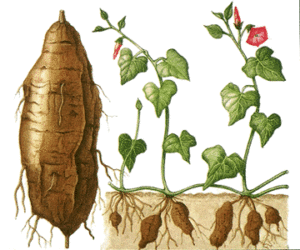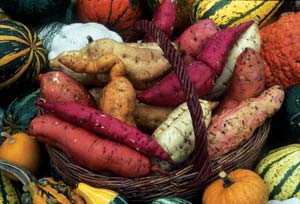We’re now taking orders for Yiftah’s bi-weekly baking. Please e-mail or phone in your orders by Friday. You can read about Yiftah’s hand-baked, sprouted bread products here.
_____________________________________
We’re left with some extra potato seeds for planting. If you have even a small piece of land where you wish to grow potatoes, let us know and we’ll send some seeds in your box.
___________________________________
A Sweet Tale of Tubers
There has been too much sun at this point in November, when the skies are supposed to be grey and wet. We’re waiting, praying for the rain, hoping it comes speedily and in abundance. In the meantime, the forecasts have been warm and sunny and thus quite dismal. We’re still hoping.
Our sweet potatoes have been confused by these sunny days. They’re used to being pulled out of the ground from the Jewish New Year holidays till the beginning of wintertime, four months after being planted in June and July, as the heat subsides to an autumn cool. This year they are blinded by the scorching sun, dried up by the hot winds.
It’s not that the sun is foreign to them. Their origins are in tropical Central America, and they’re well acquainted with the sun. The most ancient evidence of sweet potatoes, 8,000-10,000-year-old roots, was found in Peru, and documentation of sweet potatoes growing in the area dates back to 2000 BC. This yummy vegetable traveled with the conquerors of America to Europe, then to Africa, India, Southeast Asia and China in the 15th -17th centuries. In China, the sweet potato became an institution– some 85% of the world’s sweet potatoes are grown in China. In Israel, they are planted in the summer and picked in autumn. That is, when November is autumn…
The sweet potato is a member of the Convolvulaceae family, related to the wild field bindweed, the Cuscuta (dodder) and sister to the lovely morning glory. Formally known as Ipomoea batatas, it is one of the only members of this large family that is edible, and definitely the only one to be industrially grown for food. Like other members of her family, she tends to send out tendrils and twigs all over. If allowed, she will climb all over the nearest fence, covering it with a layer of heart-shaped green leaves and beautiful light-purple flowers that open in the morning and close in the afternoon sun.
We buy our sweet potato cuttings from Oded of Moshav Yesha, and receive a few bundles of damp sticks bound together with a rope. We place these bare branches into the two tall wet mounds we’ve prepared in advance. It is such a wonder to see this plant grow every year, to watch sticks turn into a beautiful green carpet dotted with purple flowers, with delicious orange roots. Last year I prepared a newsletter with a photo display of how these sticks turn into sweet potatoes. Check it out.
Like other sweet potato growers in Israel, we plant the “Georgia Jet” variety, with a reddish-pinkish peeling and bright orange flesh. But there are many other types of sweet potatoes differing in the color of their peeling (white, cream, brown, red, purple or yellow), their flesh (white, cream, yellow, purple or orange), their size and their shape. Here are some examples of the wide variety of sweet potatoes worldwide:
Years of careful selection of sweet potatoes by farmers and nature have made the sweet potato very strong and resistant (or at least tolerant) to diseases and pests. Sometimes the plants can be carriers of various pathogens that are not actively expressed and do not prevent the plant from growing or developing. Basically, the sweet potato hardly suffers from any problems, and usually grows nicely over a few months time.
After four months we begin digging them out. First we fumble around, digging in one of the far corners to see what’s hiding down there. Are there any orange tubers? How many? How large are they? Do they seem healthy? Then, if they’re nice and ready, we start digging them out. There is no need to take them out right away and store– they are well-protected in the earth, even during cold winters, due to the warmer temperature underground. If you take the sweet potatoes out of earth, they should be kept in the refrigerator so they’re not too cold. When the temperature outdoors falls lower than 13 degrees, the storage refrigerator should be at a temperature of 13-15 degrees so the sweet potatoes do not catch cold.
We keep our sweet potatoes in the packing house for a short time before sending them to you. Sweet potatoes that are mass-produced for industry and kept till the end of wintertime undergo a process called “curing.” They are pulled from the earth and warmed up in a room that is temperature and moisture-controlled. This process thickens their peelings and they grow scab-like skin to cover areas bruised during the digging-out process. These potatoes can be stored for longer periods of time.
This is also the reason that they should not be stored in your home refrigerator. The sweet potato that grows primarily in summertime does not like cold weather, and its taste will go bad if stored in the fridge. They should be stored in a cool, ventilated place, not in a bag or a sealed container, in order to prevent the accumulation of excess moisture. They do not have to be hidden from light like potatoes, because they are roots that contain no chlorophyll, and therefore will not turn green (like radishes and beets.) High temperatures will make the sweet potato sprout or ferment, which is why they should be avoided (unless you wish to make liquor).
The delicious, soothing taste of these sweet potatoes is especially joyful in the cold wintertime when you so crave a sweet vegetable. In addition, it is bursting with benefits for your health. Its orange color assures a high quantity of beta carotene which becomes vitamin A once consumed. Beta carotene is a multi-armed warrior for battling cancer, crucial for eyesight, strengthening your immune system, keeping your skin healthy and contributing to proper growth. Despite its sweet taste, it is considered an “anti-diabetic” vegetable, recommended for diabetics because of its contribution to the balancing of sugar levels in the blood, and to reducing the resistance of the cell to insulin– perhaps because of its rich carotenoid content. The sweet potato also contains a nice level of vitamins C and B, potassium, magnesium, iron and dietary fiber. This team works to control blood pressure, strengthen bones and prevent osteoporosis, and allow for proper brain function and development of learning skills in children and babies.
Many of the vitamins and dietary fibers are in the peeling, so it does not need to be peeled—just scrub it well. The sweet potato should be cooked immediately after being cut, as its skin will bleach and then oxidize once it comes into contact with the air. If you must wait, keep them in a bowl of water to prevent blackening.
As mentioned, China has an ongoing love affair with this vegetable. In Chinese medicine, it is recommended for weight loss. It strengthens the spleen, which, according to Chinese medicine, determines metabolism and our need for sweet foods and food in general. A weak spleen will create a strong need for sweets, and an inevitable weight gain. According to this approach, the body must receive naturally sweet food, i.e., there is no harm in a sweet diet, on condition that the quantity of sweets is limited, it is natural, and does not derive from processed foods like white sugar or sweets. A middle-sized sweet potato contains 150 calories (equivalent to two slices of bread), but it is very filling. Chinese medicine perceives the sweet potato to be one of the most balanced foods and therefore can be eaten by almost anyone. According to the Chinese, the orange color ties it to earth, making it a warming, strengthening food, suitable for winter.
So now that we’re prepared for winter, how about some nice, cold, rainy days, perfect for a hearty bowl of sweet potato soup?
Anxiously awaiting it…
Melissa, Alon, Bat-Ami and the Chubeza team
______________________________
What’s in our boxes?
Monday: Radishes or turnips, cilantro, lubia (cowpea) or yard long beans or okra or sweet peas, Swiss chard, parsley, red mustard, tomatoes, cucumbers, sweet potatoes, broccoli.
In the large box, in addition: eggplant, cauliflower, iceberg lettuce or arugula
Wednesday: red leaf lettuce, basil or mint, cucumbers, red mustard or tatsoi, cherry tomatoes, green onions, turnips or daikon, sweet potatoes, Swiss chard or spinach, green beans or okra or lubia (cowpea) or yard long bean – small boxes only, small boxes: cauliflower or broccoli.
In the large box, in addition: cauliflower, broccoli, beets, leeks
______________________________
Sweet potatoes recipes:
Many here:


